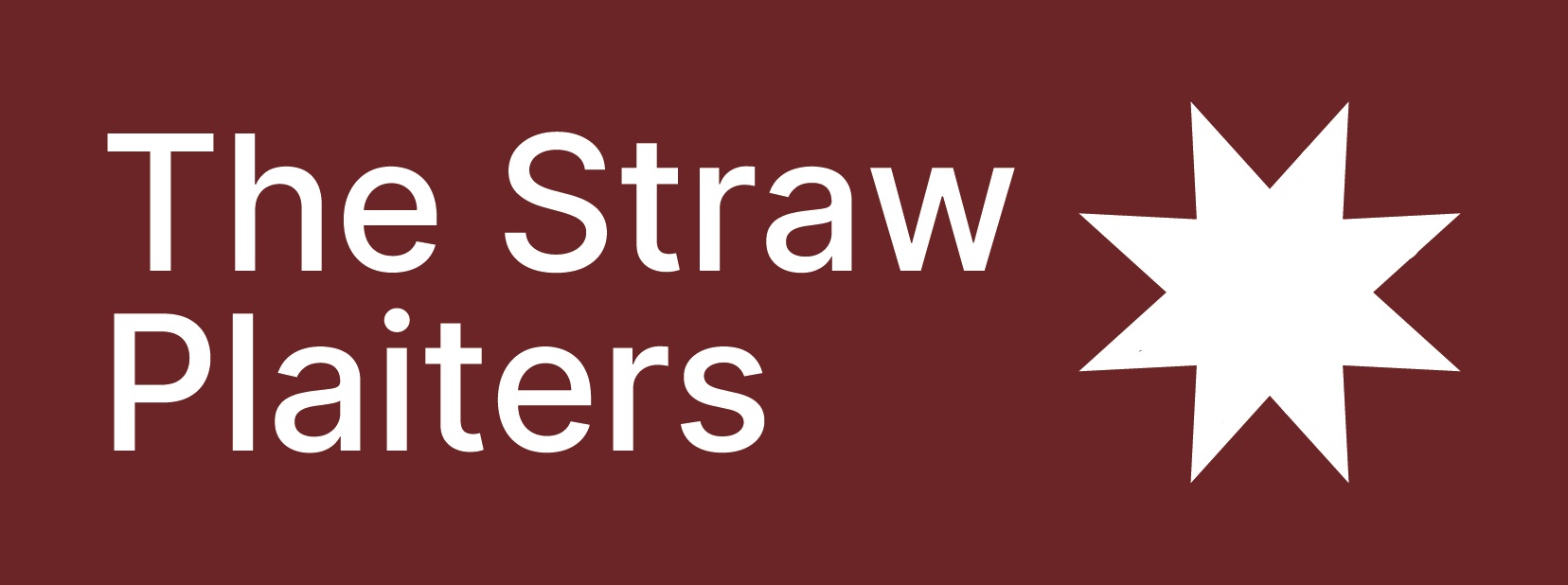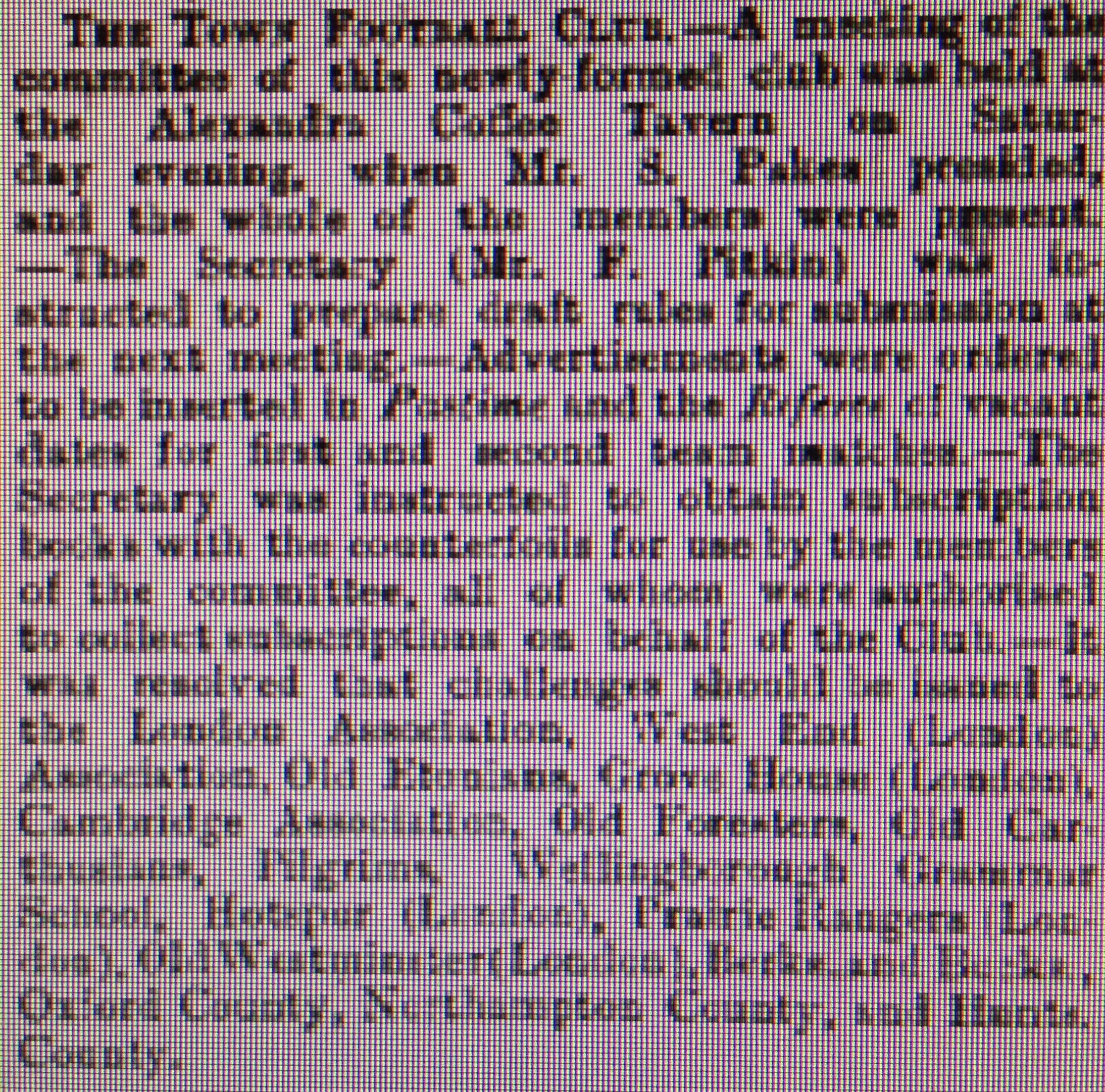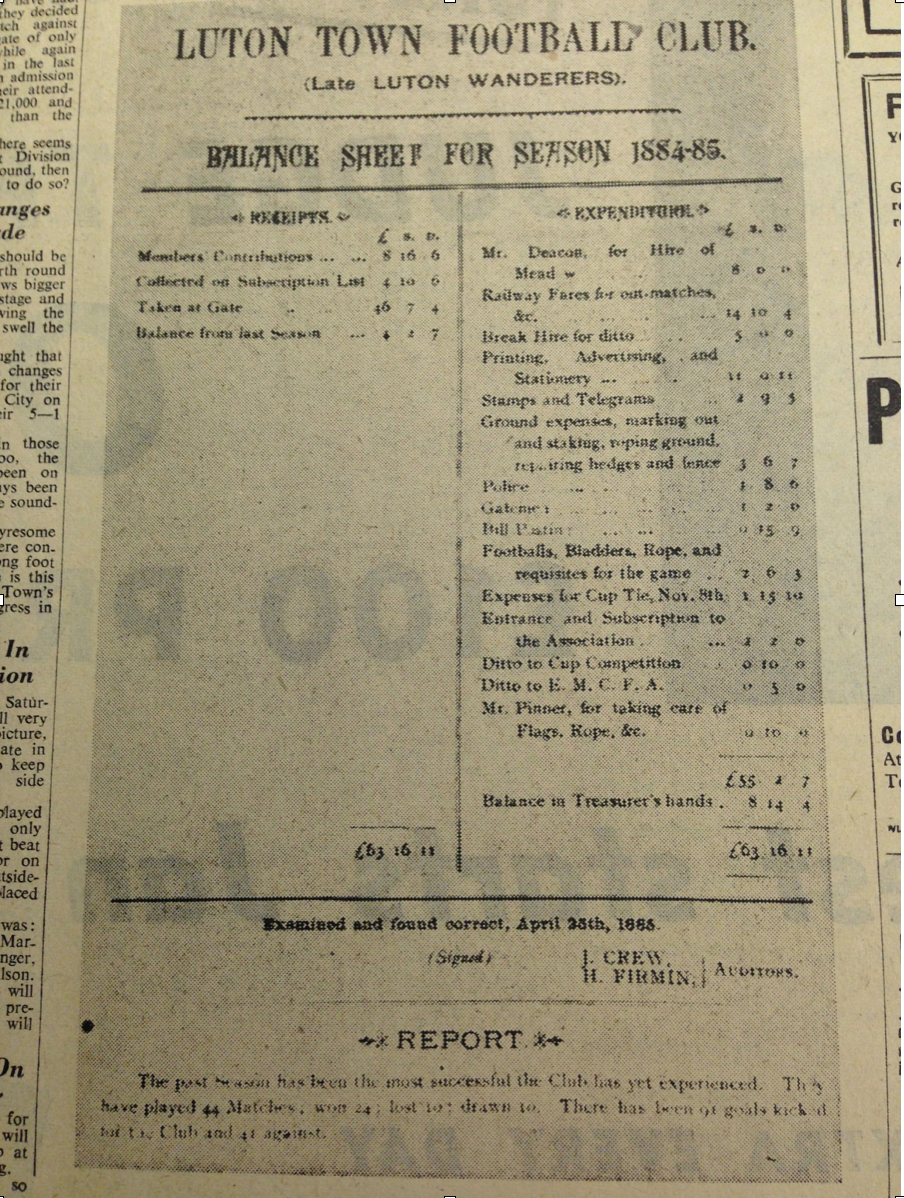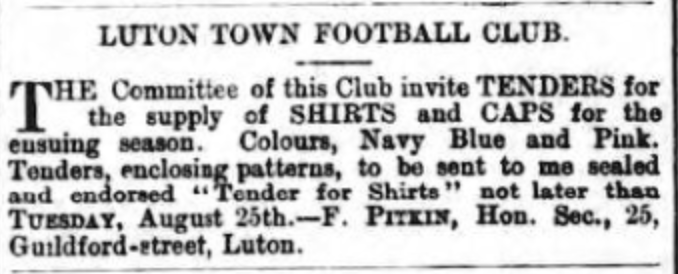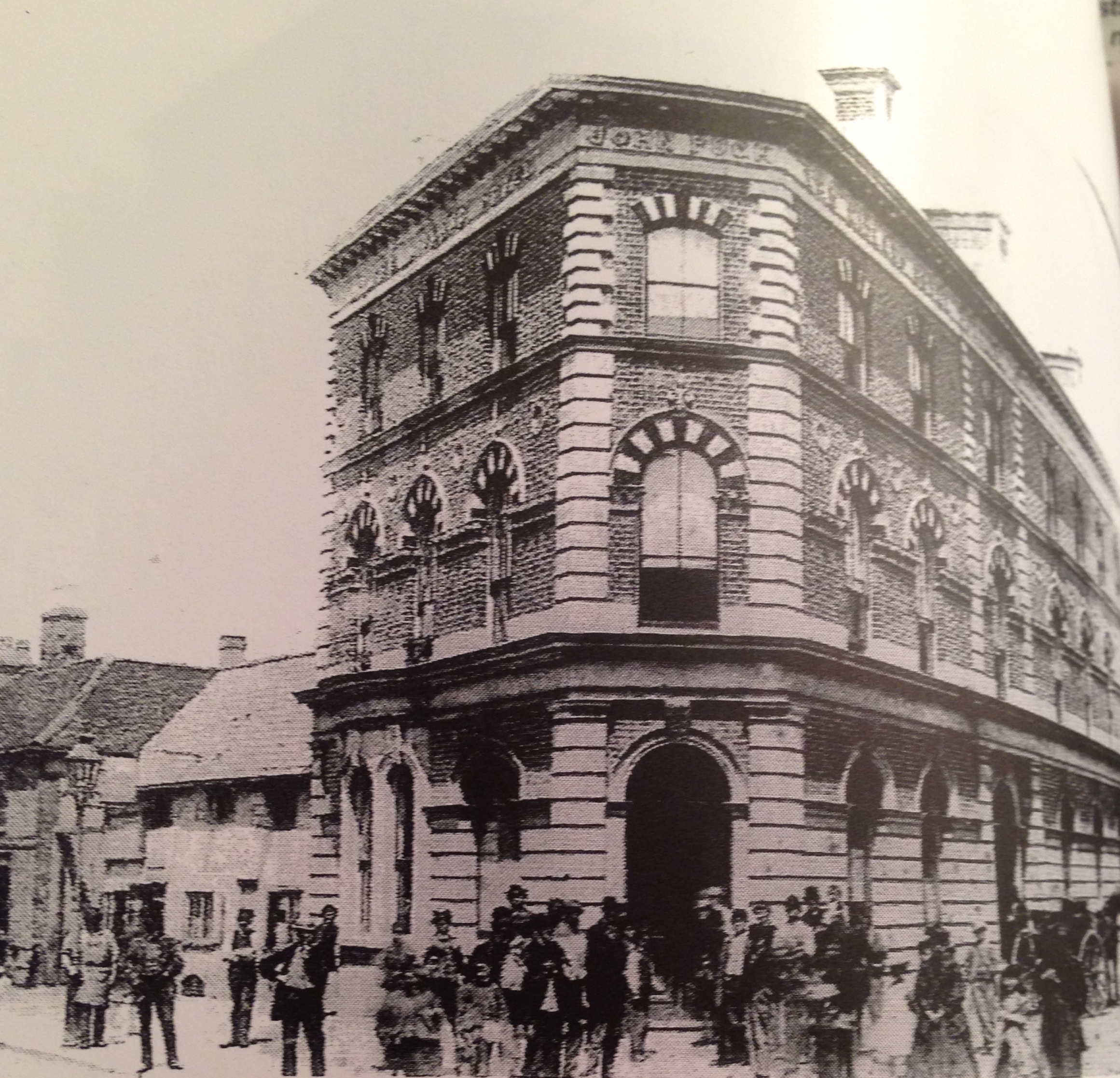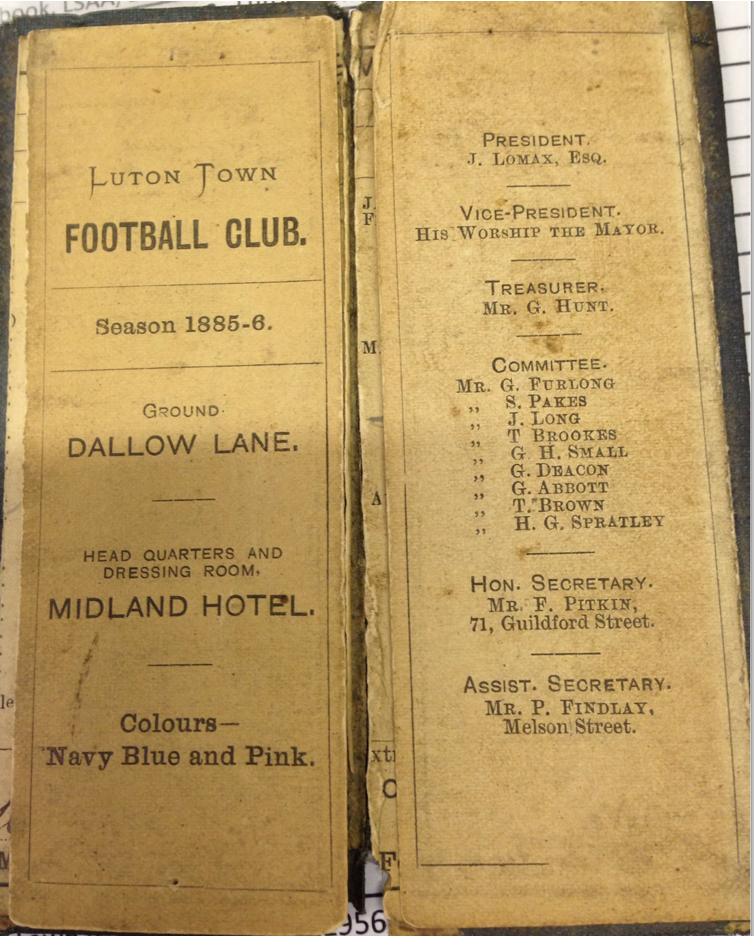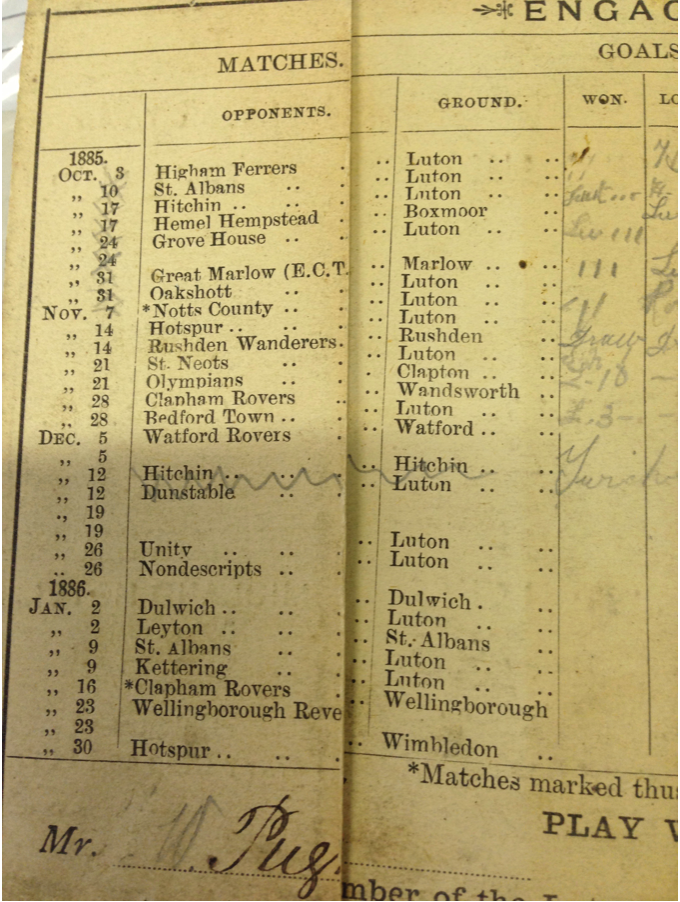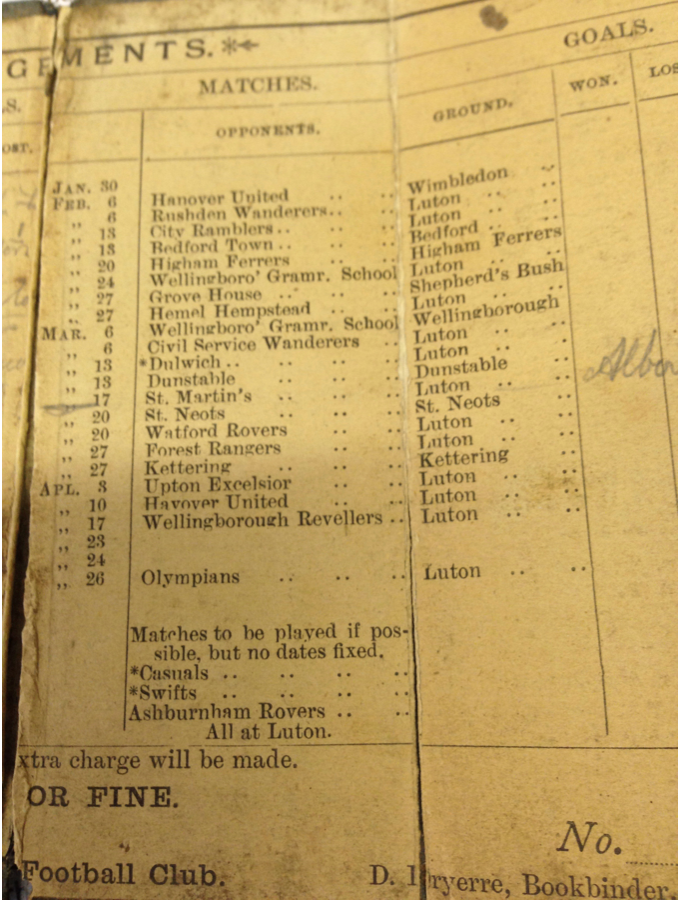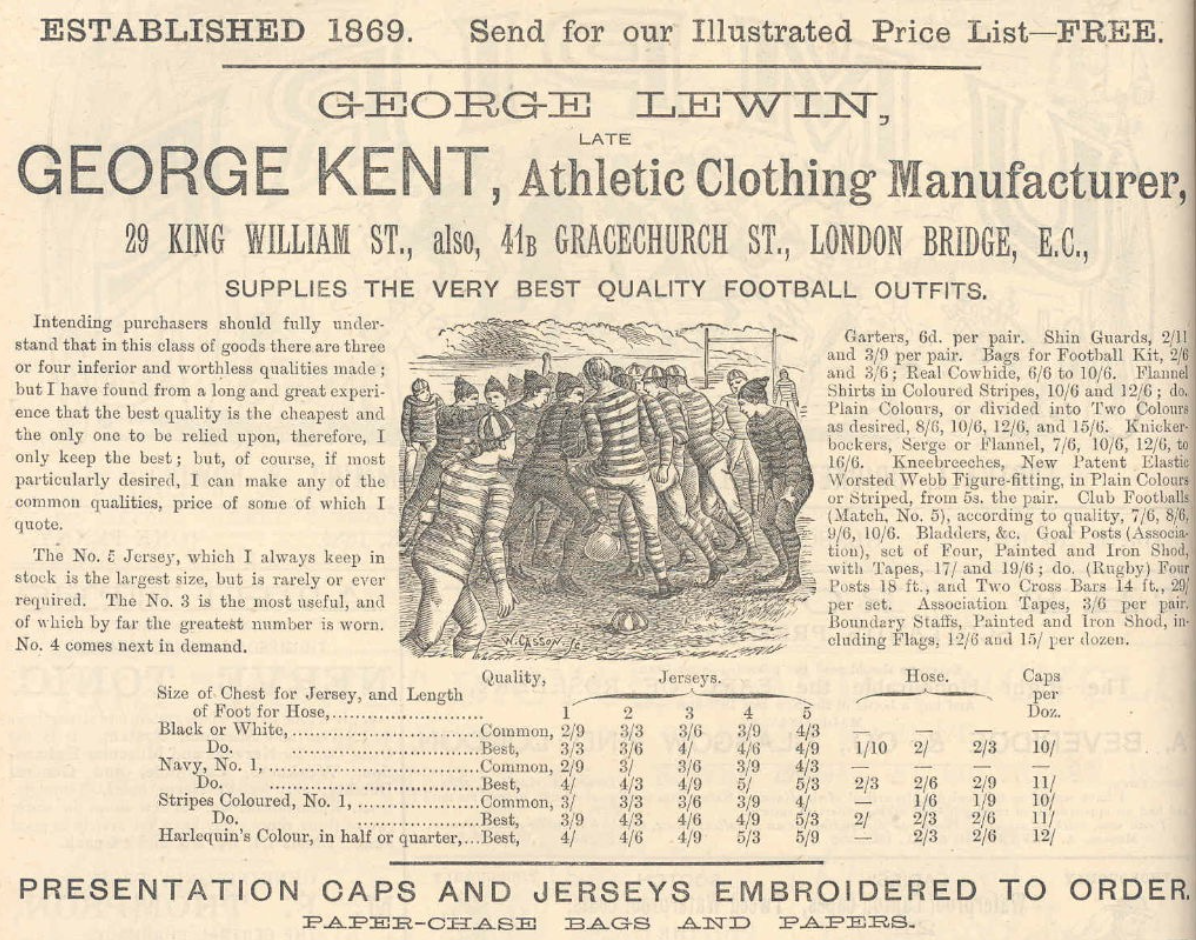CHAPTER SEVEN – CONSTRUCTION, CONFLICT AND CRISIS
Page 2 – Luton Town F.C. first committee meeting
Page 3 – Wanderers Annual General Meeting
Page 4 – Interlude
Page 5 – Crisis Averted
Page 6 – Conflict
Page 7 – Loose ends tied up
Page 8 – The fixtures for the first season
Page 9 – Pink and Navy Blue shirts!
Page 10 – Ready for the first season
We have one final game of the 1884/85 season to tie up. The Luton Reporter gives the following report from their 25th April 1885 edition. This game must have been played on the 18th April.
“Luton Town Club v Wellingborough Revellers. The Town Club finished a very successful season on Saturday with the above match, which makes 44 matches played this season, of which they have won 24, lost 10, and drawn 10. They have scored 91 goals against 42. The home team was not very strong, as they were minus the services of the Brothers Lomax, and one or two other players who generally play in the first eleven. But the team, nevertheless. deserves credit for the manner in which they acquitted themselves, keeping well together and playing a sound game, which completely baffled the visitors. Both teams at half time had scored one point each. The visitors in the second half seemed completely fagged out, and although the Luton men were playing up hill and against the wind, they succeeded in scoring three times, a very good game ending in favour of the home team by four goals to one. The Luton team was as follows:- goal – G. Long. Backs – A. Martin and H. Hucklesby. Half backs – W. Davis and W. Garrett. Forwards – A. Deacon and G. Deacon (right), R. Ellingham and W. Smith (centre), G. Worboys and T. Veale (left)”.
Note the return to the outdated 2- 2- 6 formation.
This is definitely a Wanderers match (we will see the same statistics at their AGM) although the Luton Reporter has dropped the “(late Wanderers)” description in this report. We must assume that one of the Wanderers committee wrote this report for the paper. Herbert Spratley is not in the team. Curiously the report mentions the absence of the Lomax brothers. Arthur Martin and George Deacon are in the team. They had said that they would not play for the Wanderers until the Town Club issue was resolved. They were men of their word. Having played for the Wanderers in the afternoon, George Deacon attends the first committee meeting of the newly formed Luton Town Football Club that evening. These were indeed confusing times.
———————————————-
Page 2
The first committee meeting of Luton Town Football Club took place at the Alexandra Coffee Tavern on Saturday 18th April 1885. It is interesting to note that the first and subsequent meetings of the committee took place in a Coffee House, not a Public House or Church Hall. The Temperance Movement was a very powerful voice in Victorian life and we can take an educated guess that some committee members had taken the pledge not to drink alcohol. The Alexandra Coffee Tavern was in George Street but I have not been able to discover exactly where it was.
All the members of the committee attended, including Herbert Spratley. The four Straw Hat Manufacturers, the Warehouseman, the Blocker, Block Maker, Teacher and the Woollen Spinner had the grave responsibility of creating a brand new football club. They would have the help of a solicitors clerk and a warehouseman in the form of the Secretary and Treasurer respectively. The committee was responsible for every administrative aspect of the club, and as there was no team manager this included picking the team for each game. The list of things to do before the new season started was a long one and will become apparent as the story unfolds. Some of the committee men had experience of running other clubs which would stand them in good stead. All their work would be unpaid, and it would be work that would come under the microscope of the football loving people of Luton.
Samuel Pakes took the chair. The post of chairman of the committee meeting rotated between the nine members. Motions were put to the committee and voted upon. The Chairman had the casting vote. It was agreed that draft rules were to be drawn up for submission at the next meeting. The Secretary was;
“instructed to advertise in “Pastime” and the “Referee” all vacant dates for strong first team and good medium second”.
“Pastime” and “Referee” were well known sports publications which had a wide circulation.
The minute book adds that
“it was decided that the Secretary send amongst other challenges to the following clubs:- Old Etonians, Grove House, Old Forresters, Old Wykehamists, Wellingboro’ Grammar School, Prairie Rangers, Hendon, Old Westminster’s, Hotspur, Berks and Bucks, St Albans etc etc”.
The challenges, made to some very strong clubs, demonstrates the ambition that the club adopted from the beginning.
The committee also instructed the Secretary to see Mr John Saunders with reference to hiring his meadow in Dallow Lane for the next season. However, an advert (below, apologies for the quality) in the Luton Reporter of 11th April 1885 announced the sale of Dallow Farm. Mr Scarborough w as selling up. The meadows, upon which Excelsior had played and upon which many of the town’s outdoor events were staged, were to change hands. Would the new owners be as accommodating?
as selling up. The meadows, upon which Excelsior had played and upon which many of the town’s outdoor events were staged, were to change hands. Would the new owners be as accommodating?
The committee also agreed to obtain 12 books containing 50 tickets each with counterfoils. The books were to be used exclusively by the committee members to collect subscriptions.
There were 600 tickets for members paying 2s 6d each which would raise a total of £75 per year, if they were all sold. The members would gain free admission to all the home games in the coming season. For non members, admission had to be paid at the gate, initially set at 2d but 3d for big games. Members were able to practice on the Dallow Lane Meadow when they were allowed by the club. Only members could play for the club. No concession rate is mentioned so we must assume rich gentlemen such as the Lomax brothers paid the same as the working class blockers. The expense for the players could mount if they had to take time off work in order to play.
The following week the committee resolved that the club should join the East Midlands Counties Football Association (E.M.C.F.A.). This Association appears to have included Bedfordshire, Huntingdonshire, Rutland and parts of Northamptonshire. Northampton and District was a separate Association which appears to co-operate on occasions with the E.M.C.F.A. but already had it’s own cup competition.
———————————————
Page 3
Wanderers held their annual general meeting the same week to conclude an eventful season. The Luton Reporter, in which they again call the Wanderers by the title “Town Football Club.” –
“Town Football Club. The annual supper of the above club was held at the “Cricketers Arms”, on Monday evening, when a large number of friends and members sat down to an excellent repast, provided by the treasurer (Mr G. Bennett). When the cloth was removed, the rest of the evening (after the report and balance sheet for the last season had been read and approved of) was devoted to harmony, most of those present obliging with songs, etc., and a very enjoyable evening was spent. The report stated that the club had played 44 matches, won 24, lost 10, drawn 10. There has been 91 goals kicked for the club, and only 42 against it. The club entered into the English Challenge Cup Competition, and were drawn against the Old Etonians on Nov 8th, and lost by 1 goal to 3. They had played a benefit match for the Luton Town C.C. and one for the Bute Hospital. There had been £63 16s 11d taken at the gate, members subscriptions etc, whilst total expenses came to £55 2s 7d, which left a balance of £8 14s 4d in the treasurer’s hands for next season”.
———————————
Page 4
INTERLUDE
The sporting calendar was turned over to the cricket season for the summer. There was no overlap of the football and cricket season as many of the pitches were used by both sports. Cricket was a well ordered game and regarded by most as the national game. Parents of youngsters were happier if their son played cricket rather that football, which was considered a rough game. The decisions in cricket were not questioned by those participating or watching and there was no physical contact. Samuel Pakes, Herbert Spratley, John Long, George Deacon, J.C. Lomax, G.H. Small and other major figures in the town played the summer game. George “Chubby” Deacon represented Bedfordshire three times and in one match at St. Albans scored 111 and took 8 wickets.
St. John’s College had a cricket team in which G.W. and C.A. Beldam, L. Narburg and J.R. Benavides played. The latter three would all play for Luton Town. Albany’s cricket team included future Luton players, A.J. Deamer, J. Moody, W. Miller and A. Sanders. Excelsior, Christ Church Institute and Star also had cricket teams.
On Saturday 9th May 1885 an inquest was held in Luton as to the death of the celebrated gymnast and trapeze artist, the Marquis de Gonza (whose real name was Algar). He had died suddenly the previous day. The cause of death was Syncope – a blackout caused by a sudden lack of oxygen to the brain.
Luton Mayor George Wilcox Gilder was succeeded by Mayor William Mayles.
There was a major national event in Luton that summer. Straw plaiting was in a depressed condition in 1885. An exhibition was arranged to promote the industry and some distinguished guests attended the opening day. On the 19th, 20th and 21st August 1885 the exhibition took place at the Plait Halls, Waller Street Luton – entrance on Cheapside. The patrons were Queen Mary and The Duke of Teck. and it was officially opened by Prince and Princess Edward of Saxe Weimar. A National news paper said of Luton;
“Everyone knows that the clean, busy town, set in the green enamelled country which is framed by wood-crowned hills and the sweeping outline of the Chiltern Range, is the centre of this ancient art and mystery”.
The Beds Coffee Tavern Company sixth annual statement stated that the trade was in depression with much reduced trade;
“the competition has, however, been much increased by the opening of private coffee taverns and political clubs both at Bedford and Luton”.
The company therefore showed a loss of £118 19s 5d for the year.
The figures for the 1884 hat trade exports were released. The total value of the exports was £1,151,677 with straw hats alone worth £381,168. Australasia was the biggest customer of straw hats followed by France, “British North America” then the “Foreign West Indies”.
In World News, the Luton Times reported that a great battle had been fought on the Afghan frontier at Penj-Deh. The Afghans were totally routed and 500 killed. America came out of a three year depression. On 22nd May, Victor Hugo poet, playwright, novelist and statesman died. On 23rd July Ulysees S. Grant, the Union Civil War General and 18th President of the United States of America died. On 6th July Louis Pasteur successfully tested his vaccine against rabies
In sport, Bob Martin of Scotland won the British Open Championship at the home of Golf, St Andrews. The Wimbledon tennis finals were an all British affairs with William Renshaw and Maud Watson the respective men’s and women’s singles champions. James Cowie won the Amateur Athletics Association 100 yards sprint title in a time of 10.2 seconds. The following year he was defeated by Arthur Wharton in a world record time of 10.1.
———————————————
Page 5
As preparations for the new season were well under way there was a crisis for the club. At a committee meeting on 10th August, the Secretary, Frank Pitkin, tendered his resignation. The duty of the Secretary was to arrange the fixtures, conduct all correspondence on behalf of the club and see through the many decisions made by the committee. It was a vital position which required many hours of work. Frank Pitkin was not a well man and as can be seen from his profile under the “Biographies” button. He assisted many other organisations in an unpaid capacity and it may be that he had spread himself too thin.
Frank Pitkin withdrew his resignation when it was agreed that Ernest Lomax would take all responsibility;
“of making such the matches and Mr Long the obtaining of all the players for such matches”.
There must have been prior knowledge of Frank Pitkin’s decision as Ernest Lomax was not at the meeting as he was not a committee member. Ernest Lomax was attending Peterhouse College at Cambridge University and was actually working hard for his B.A. This was a time when letters, postcards and telegrams were the foremost means of communication. This means Ernest would have had to write to the other teams, await their reply and then write to the committee to agree the fixture. The committee would then have to agree and write back to Ernest in Cambridge who would write to the team to confirm the fixture.
It appears a very cumbersome arrangement but the postal system was efficient and postcards were sent and delivered the same day within a certain radius. I have seen a series of postcards written by a young man from Luton to his girlfriend in Barton, asking her to meet him that same evening at a different location to normal. She replied later that day acknowledging the change.
The committee meeting also proposed;
“that the collecting books be brought in at each committee meeting, the books checked and the amount collected and paid over to the chairman or secretary”.
Money had to be carefully looked after and collected to meet the costs of the new club.
An advert, below, was placed in the Luton Times on the 21st August 1885 asking for tenders for supplying the navy blue and pink shirts and caps.
In the meantime Wanderers held a meeting at St. Matthews School, Havelock Road, on 26th August to elect officers for the coming season.
——————————————
Page 6
Another crisis arose at the next Luton Town committee meeting on 2nd September. Herbert Spratley and Mr Brook Knowles were at the meeting. The minutes show that;
“Mr Long mentioned that it had come to his knowledge that two members of this committee, Messrs Brook Knowles and Spratley had recently (and since their appointment on the committee of the Town Club) accepted office in the Wanderers (Luton) Football Club. Mr Spratley having become its secretary”.
The following is then crossed out of the minute book;
“By doing so he considered that Messrs Knowles and Spratley had been guilty of a breach of good faith towards this club”.
We recall the newspaper report of the 11th April meeting which stated that many in the town had expected a fight. Whether tempers had cooled is a matter of conjecture. However, John Long did not flinch in raising the subject face-to-face with Spratley and Knowles. The minutes continue;
“A long discussion took place on the point raised by Mr Long and the majority of this committee were of the opinion that the retention of office by any acting member of this committee in any club other than this was inconsistent and that in the interest of this and the Wanderers club it was advisable that each of the members named by Mr Long should resign his position on the committee of either one of the two clubs – Messrs Knowles and Spratley declined to this proposition and the matter was ultimately adjourned for further consideration at the next meeting”.
Herbert Spratley continues his pantomime villain role but he may have been technically correct as there does not appear to have been any rule to the contrary. Although the first committee meeting had directed that a set of rules be drawn up, we have no confirmation that this was done. No rule forbidding membership of two clubs is mentioned in the minutes. Herbert Spratley took exception to the issue and would not attend another committee meeting for six weeks.
The committee also “proposed that the Notts County match be played at Luton”.
——————————————-
Page 7
On the 9th September Mr Brook Knowles intimated to the committee meeting
“that he intended to resign his position on the committee of The Luton Wanderers Football Club and to retain his present position on the committee of this club”.
There is no mention of Mr Spratley.
Other interesting notes in the minutes show the nitty gritty of running a new club. The first practice match was arranged for Saturday 12th September. The Midland Hotel (Below) in Manchester Street was agreed to be the headquarters of the club. The periodical called “Pastime” was ordered for the use of members of the club and that it be paid for out of the funds of the club.
Finally, Mr Long and Mr Knowles were
“authorised to buy scaffold poles to be made into goal posts, and also a ball for practice”. Mr Knowles seems to have launched himself straight into the work of the committee.
The hire of the Dallow Lane ground had been mentioned at the first committee meeting back on the 18th April. Only in the middle of September was another crisis averted and an agreement reached. The cost of hiring the meadow in Dallow Lane was revealed at £5.5.0 and paid to Mr Sanders for the hire for the year. A Mr Pinney was to be approached for a price for storing “the whole of the materials of the club”. It was later reported that 10/4 be paid to Mr Pinney for a whole season storage. The pitch also had to be looked after and the committee agreed that Mr T. B. Knowles be
“allowed the sum of 2/6 per match as a remuneration for attending to the ground and also to the materials of the club”.
Seven committee members were present when a motion was considered that showed intent to the rest of the town.
“It was unanimously resolved that this club play no other club resident in the Borough of Luton”.
This arrogant yet confident statement was clearly aimed at the Wanderers but it meant that they could be faced with a dilemma if they entered a cup competition. The two cup competitions we have mentioned to date are the Northants and District Association Cup and the F.A. Cup. There had been no mention of entering the former competition but entering the F.A. Cup was a given. The decision meant that Luton could not enter any local cup competition. If they were knocked out of the F.A. Cup early then they would have just one competitive match that season.
Another effect of the decision would be a lack of flexibility. If there were postponements then playing a local team at short notice would have been a option to maintain match sharpness and fitness. A game against Albany and St. John’s College would provide a good test for the new team. While the decision may have been taken for good reasons it was a short sighted one.
The Luton Reporter announced that Luton Town;
“has an excellent match-card for the season, the number amounting to about 40, and including some capital matches. There will be a practice in Dallow-lane field on Saturday (to-morrow) afternoon at 3.30, when intending members are invited by the committee to attend”.
The fixture list was produced in a card for the members.
19th December was left blank on the fixture card which also announced other matches to be played if possible against Casuals, Swifts and Ashburnham Rovers, all at Luton.
There were some prominent clubs in the fixture list. Notts County were one of the oldest clubs and one of the best teams in the country. Hotspur, Grove House, St. Martin’s Athletic, Hanover United and Clapham Rovers would be formidable tests for the new club. Hotspur would reach the final of the London Senior Cup in 1886 losing to Ashburnham Rovers. Wellingborough Grammar School were a very strong team as were Marlow who Luton Town would meet in their first competitive match. Vulcans were another top team that would visit Luton during the season although not on the fixture list. As we will see, the fixture list changed. The weather played a part as it appears to have been one of the worse winters for years. Also teams pulled out for various reasons such as illness, lack of money or cup ties. West Bromwich Albion had stopped producing fixture lists a couple of years earlier because it was unreliable. Making an arrangement then cancelling it caused much work for the Secretary and could undermine supporters confidence. We shall look at the Secretary’s duties in due course.
The reports on the games were supposed to be produced by the Assistant Secretary and given to the Luton Reporter Newspaper. However, it appears that when the Assistant Secretary did not attend the game no report was written or submitted. In addition, there were many editions when the newspapers concentrated on politics and devoted pages to debates and cut back on other news such as football. We will consider the role of the newspapers in a future chapter.
The paper continues;
“The first match of the season in connection with the Town Football club will be played in the club fielding Dallow-lane on Saturday afternoon between teams captained by Messrs E.H. and J.C. Lomax respectively. Play will commence at 4 o’clock”.
It was later reported to have been a good game and ended in a victory for E.H. Lomax’s side by two goals to one. This was described as a “scratch” match which I assume to be one where they pick teams on the day and it was used for fitness and selection purposes.
Interlude – On 12th September the result that we all remember, Arbroath 36 Bon Accord 0.
—————————————-
Page 9
Finally, the Luton Reporter on the 19th September was an announcement by Luton Town. Messrs Beecrofts won the tender for the navy blue and pink shirts and caps. The announcement read; “The Committee have issued a notice to the effect that all members wishing to play in the matches for this Club during the ensuing season are requested to apply at once to Messrs Beecroft and Sons for shirts etc. This notice has been rendered necessary by the fact that no member will be allowed to play in a match unless he wears the Club colours”.
 Spratley’s (advert left) was the only sports shop in town and seems to have been run by a relative of Herbert Spratley (possibly his father). Beecrofts was a general clothing store located at 2 Bute Street but they had access to football gear via their suppliers. Was this another thread of the conflict? It certainly seems so. Another question which we have all asked is why pink and dark blue halves? Were they the favourite racing colours of the locals? Or rugby club? Luton Town Cricket Club would fold and not be resurrected until the 1920’s when they chose verdant green and yellow as their colours. We do not therefore know what colours they wore in 1885. The photos of the cricketers caps certainly could be dark blue and pink. As we have seen there was certainly a strong link between cricket and football in the town.
Spratley’s (advert left) was the only sports shop in town and seems to have been run by a relative of Herbert Spratley (possibly his father). Beecrofts was a general clothing store located at 2 Bute Street but they had access to football gear via their suppliers. Was this another thread of the conflict? It certainly seems so. Another question which we have all asked is why pink and dark blue halves? Were they the favourite racing colours of the locals? Or rugby club? Luton Town Cricket Club would fold and not be resurrected until the 1920’s when they chose verdant green and yellow as their colours. We do not therefore know what colours they wore in 1885. The photos of the cricketers caps certainly could be dark blue and pink. As we have seen there was certainly a strong link between cricket and football in the town.
We do not know the colours of Wanderers or Excelsior or any other club in the town at this time. Perhaps Wanderers played in one colour and Excelsior the other thus promoting the merger/amalgamation myth.
An alternative might just be plain marketing. The Old Carthusians played in maroon, dark blue and pink stripes. The Old Westminsters also appear to have worn a pink shirt. Dulwich Hamlets are the only other team famous for wearing those colours. From thehamlethistorian.blogspot.co.uk
“Talking of Dulwich Hamlet FC which formed in 1893 – The earliest reference we have found to ‘the pink and blues’ is from a South London Press newspaper of January 1896. The Hamlet’s fetching colours would put Dulwich among an elite group of football clubs that wore pink. This gave Dulwich something special – instant recognition as they took the field. It could be said that it was a marketing stroke of genius”.
As Dulwich Hamlet were not formed until 1893 it is clear that Luton Town did not copy them. But marketing is nothing new as we can see. There is no pink and dark blue shirt in existence today or even a photo of one. Unless you can help.
Above is an advert from 1885 and you will see some prices at the bottom. Not only did Luton Town choose unique colours they also chose the most expensive type of shirt too. Plain shirts were the cheapest, then stripes and harlequin in half or quarter the most expensive. If you were a big lad then it could set you back 5s 9d. Half shirts had become popular with Blackburn Rovers winning three F.A. Cup finals in a row, 1883, 1884 and 1885, in light blue and white half shirts.
The rest of the advert lists most of the things that a club would need for a game. Beecrofts were able to send off for any of the items on the list. Spratley’s shop in Barber’s Lane would have stocked some of the items of course.
———————————————
Page 10
Interlude – The Luton Times gave some hints for the home – a recipe for salmon fritters, a warning not to make tea in a tin pot and some helpful tips on how to avoid Cholera!
At a general meeting of the East Midlands Counties Football Association held at Bedford;
“it was decided to establish a challenge cup competition. All clubs wishing to compete in the same are desired to join the association at once, so there can be no delay in drawing the ties”.
The Luton Town committee’s short sighted decision not to play any other club in the borough immediately came back to haunt them before a ball had even been kicked. Football was in its infancy in the town and the committee men were unpaid volunteers so mistakes were bound to be made. All was not lost as committee decisions could always be reversed with another vote.
Another reason to overturn that decision was that while the first team had set their sights high, the reserves would need opponents. Playing strong teams such as Luton Rovers, St. John’s College and Albany would be a good test and demonstrate which players were in good form and ready for the first team. The demise of Excelsior meant that some of their players would be available to strengthen other teams. They might also form their own teams as the popularity of the game in Luton increased.
In view of the decision not to play a team from Luton, the opposition would have to be chosen carefully. At home games the crowds would (hopefully) turn up and the gate money would cover the opposition’s travel expenses. This arrangement was the general rule. However, if Luton Town travelled to poorly supported opponents, then it may have to meet some or all of its own travel expenses. It would require some careful management by the Secretary and Treasurer.
The town had the club it wanted. All the necessary administrative duties had been completed. The fixtures had been arranged. It was now up to the people of Luton to support the Straw Plaiters.
Thanks to;
The staff at Wardown Park Museum, part of Luton Culture
The History of Luton by William Austin
The Luton News
“The Victorian Football Miscellany” by Paul Brown
“Athletics and Football” by Montague Sherman 1887
